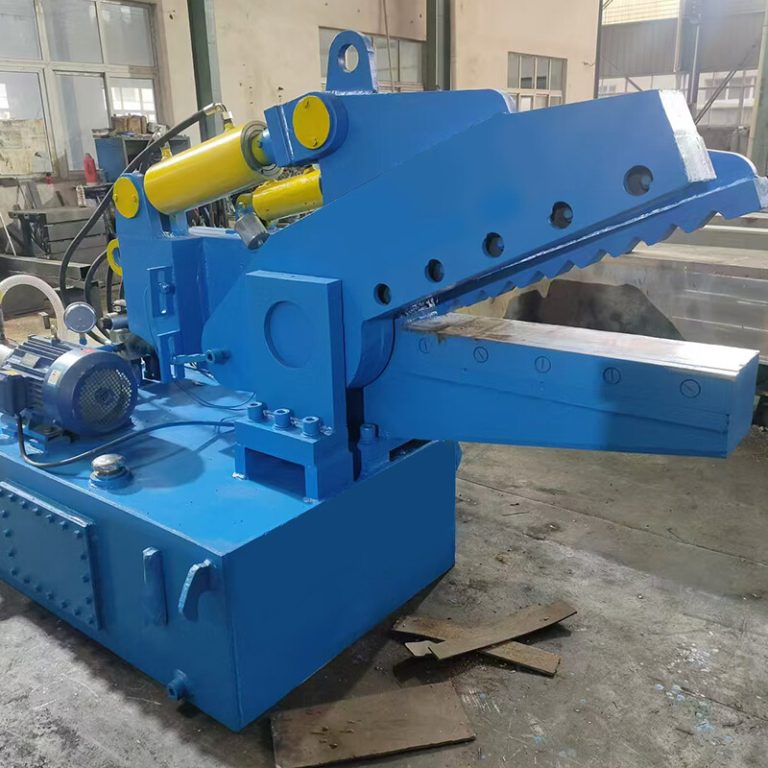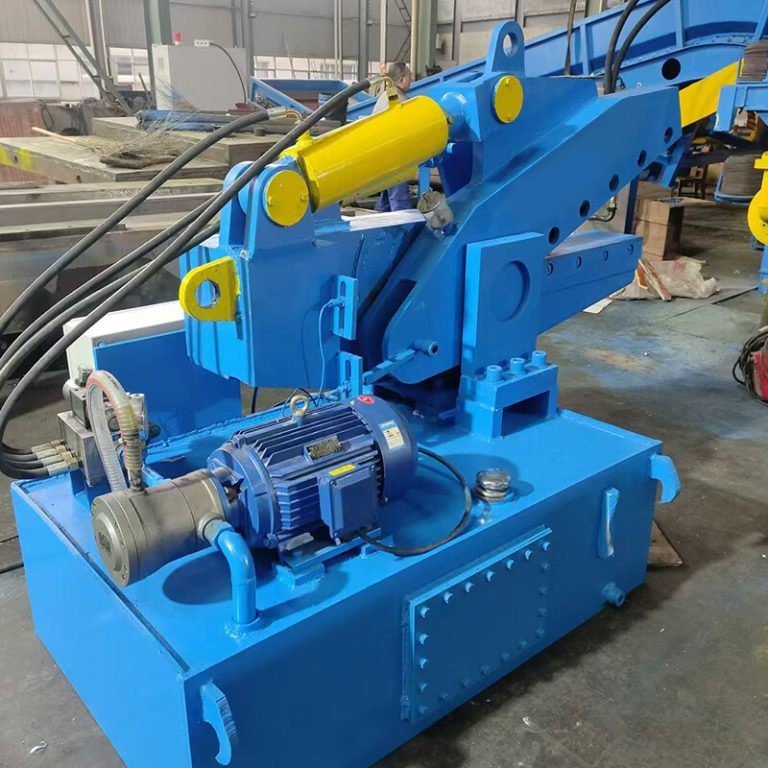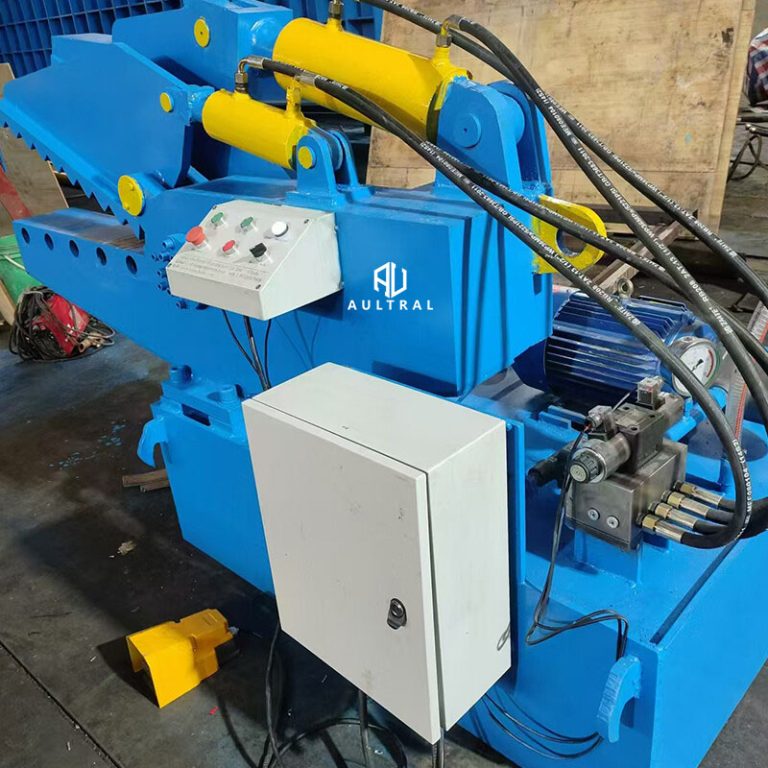What is an Alligator Shear?

An alligator shear is a powerful industrial cutting machine designed for processing metal materials like steel bars, rebar, pipes, and scrap metal. Named for its distinctive jaw-like cutting mechanism that resembles an alligator’s bite, this equipment features a stationary lower blade and a hydraulically-powered upper blade that delivers tremendous shearing force in a guillotine-style cutting action. The machine’s robust construction allows it to effortlessly cut through tough metals, making it indispensable in metal recycling yards, demolition sites, and steel fabrication workshops. Unlike more complex cutting systems, alligator shears offer a straightforward yet highly effective solution for reducing large metal pieces into manageable sizes. Their simple hydraulic or mechanical operation ensures reliable performance with minimal maintenance requirements, while built-in safety features protect operators during use. Commonly found in scrap processing facilities, these shears play a crucial role in preparing metal waste for recycling by cutting materials to optimal sizes for melting or further processing. The combination of brute cutting force, operational simplicity, and cost-effectiveness has made alligator shears a fundamental tool in metalworking industries where heavy-duty cutting of rigid materials is routinely required. Their ability to handle a wide range of metal thicknesses and types while maintaining consistent cutting performance explains their widespread adoption across various industrial applications.
Why Use an Alligator Shear?

Alligator shears have become indispensable equipment in metal processing industries due to their unique combination of power, efficiency, and cost-effectiveness. These heavy-duty cutting machines offer distinct advantages that make them superior to alternative metal cutting methods in many industrial scenarios.
The primary reason for using an alligator shear lies in its exceptional cutting capability for thick, hard metals. Unlike band saws or plasma cutters that may struggle with dense materials, alligator shears utilize tremendous hydraulic force to cleanly shear through steel bars, rebar, pipes, and scrap metal up to several inches thick. This brute-force approach ensures consistent performance even when processing tough or irregularly shaped metal pieces that would challenge other cutting systems. The shearing action produces minimal metal distortion compared to thermal cutting methods, preserving material integrity for recycling or fabrication purposes.
Efficiency represents another compelling reason for choosing alligator shears. These machines dramatically reduce processing time in metal recycling operations, where workers need to quickly reduce large scrap items into manageable sizes. A single operator can process hundreds of cuts per hour with minimal effort, thanks to the machine’s simple lever or pedal operation. This productivity boost translates directly to labor cost savings and increased throughput in scrap yards and demolition sites. The continuous operation capability of hydraulic models further enhances this efficiency advantage.
From an economic perspective, alligator shears offer significant cost benefits. Their relatively simple mechanical design requires less maintenance than more complex cutting systems, and their durable construction ensures years of reliable service with proper care. The absence of expensive consumables (like plasma cutter nozzles or saw blades) and lower energy requirements compared to thermal cutting methods make them a cost-efficient solution for high-volume operations. Many operations find the return on investment compelling when replacing manual cutting methods or older, less efficient equipment.
Safety considerations also favor alligator shears in many applications. While all metal cutting involves some risk, the enclosed cutting area and controlled operation of alligator shears reduce exposure to flying sparks or molten metal associated with torch cutting. Modern models incorporate important safety features like emergency stop buttons, protective guards, and two-hand operation systems that help prevent accidents when properly utilized.
The versatility of alligator shears makes them suitable for diverse applications across multiple industries. Metal recycling facilities use them to prepare scrap for melting, demolition crews employ them to dismantle structural steel, and fabrication shops utilize them for cutting reinforcement materials. Their ability to handle various metal types and sizes with quick blade changes adds to their utility in operations dealing with mixed metal streams.
Environmental factors also contribute to their popularity. Unlike thermal cutting methods that produce fumes or require special ventilation, alligator shears operate cleanly without generating hazardous byproducts. This makes them preferable for indoor operations or facilities with strict environmental regulations.
In summary, industries choose alligator shears because they deliver unmatched performance in cutting capacity, operational efficiency, and cost-effectiveness for heavy metal processing. Their robust construction ensures reliability in demanding environments, while their safety features and environmental advantages make them a responsible choice. For operations requiring high-volume metal cutting without the complexity and expense of high-tech alternatives, alligator shears remain the practical, proven solution that continues to demonstrate its value daily in metalworking industries worldwide.
How to Use an Alligator Shear?

An alligator shear is a powerful industrial cutting machine designed for processing metal materials such as steel bars, rebar, pipes, and scrap metal. Proper operation ensures both efficiency and safety in metal recycling yards, demolition sites, and fabrication workshops. Below is a comprehensive guide on how to safely and effectively use an alligator shear.
1. Pre-Operation Preparation
Before starting the machine, conduct a thorough inspection to ensure it’s in proper working condition. Check the hydraulic system for leaks and verify that the hydraulic oil level is adequate. Inspect the blades for sharpness and wear; dull or damaged blades should be replaced immediately to maintain cutting efficiency and prevent unnecessary strain on the machine. Examine all bolts and fasteners to ensure they are tight, and confirm that electrical connections (if applicable) are secure. Operators must wear appropriate personal protective equipment (PPE), including safety goggles, heavy-duty gloves, a hard hat, and steel-toe boots to protect against flying metal fragments.
2. Machine Startup and Testing
Power on the alligator shear and allow the hydraulic system to warm up for a few minutes (for hydraulic models). Listen for any unusual noises that might indicate mechanical issues. Test the shear by performing a few empty cutting cycles to verify that the blades are moving smoothly and the controls are responsive. Ensure the emergency stop button is functional before proceeding with actual cutting operations.
3. Material Positioning and Cutting
Place the metal piece to be cut between the lower fixed blade and the upper movable blade. Position the material so that the intended cutting line aligns with the blade’s edge for a clean cut. Avoid overloading the shear by attempting to cut materials that exceed its maximum capacity, as this can damage the machine or cause safety hazards. Activate the cutting mechanism using the control lever or pedal, depending on the machine’s design. The hydraulic cylinder will drive the upper blade downward with tremendous force, cleanly shearing through the metal.
4. Post-Cutting Procedures
After completing the cut, allow the upper blade to fully retract before removing the cut pieces. Clear away any metal scraps or debris from the work area to prevent tripping hazards or interference with subsequent cuts. Periodically check the blade condition during extended operation, as continuous use can cause overheating or premature wear.
5. Shutdown and Maintenance
When finished, power down the machine and perform basic maintenance. Wipe down the blades to remove metal shavings and apply a light coat of oil to prevent rust. Regularly inspect hydraulic hoses and replace them if signs of wear appear. Proper lubrication of moving parts should be performed according to the manufacturer’s schedule to ensure long-term reliability.
Safety Considerations
Never place hands near the cutting area while the machine is operating.
Always use push sticks or other tools to position small or irregularly shaped metal pieces.
Keep the work area clean and well-lit to avoid accidents.
Only trained personnel should operate the alligator shear.
By following these guidelines, operators can maximize productivity while maintaining a safe working environment. Alligator shears are robust tools that, when used correctly, significantly enhance efficiency in metal processing operations.
